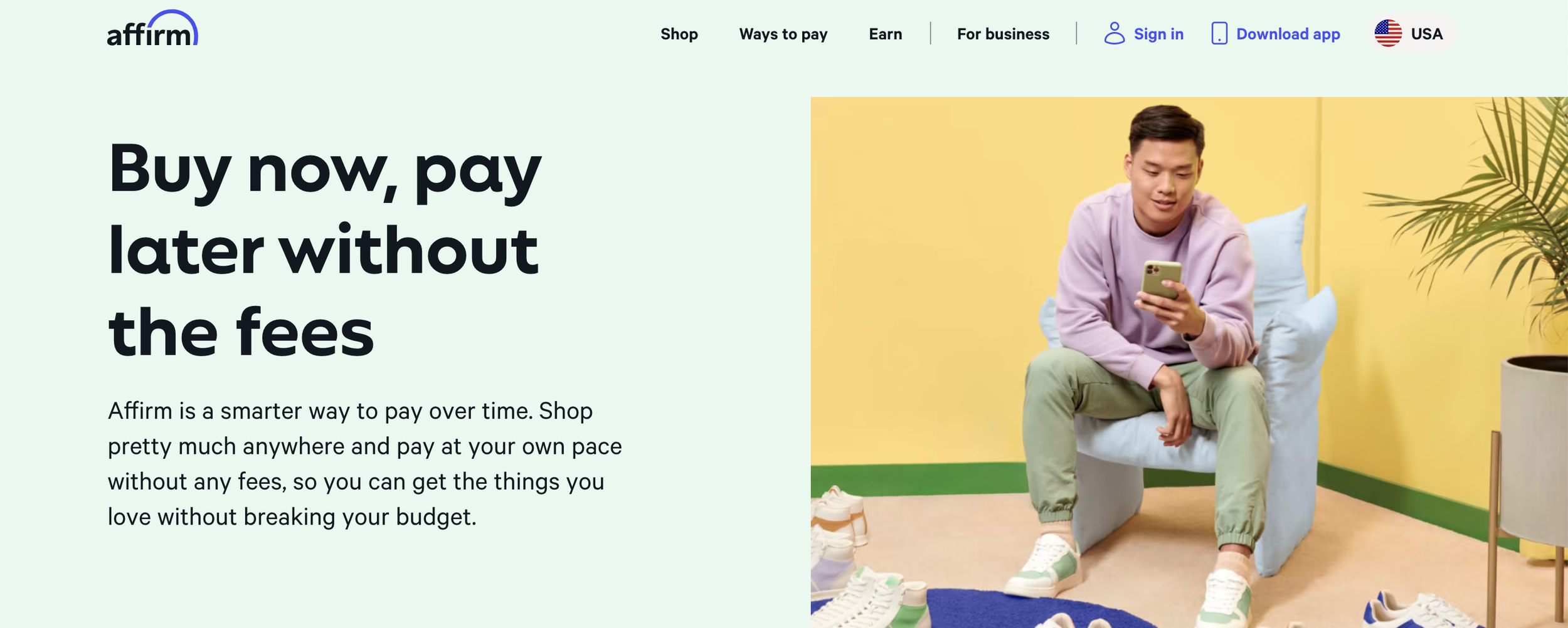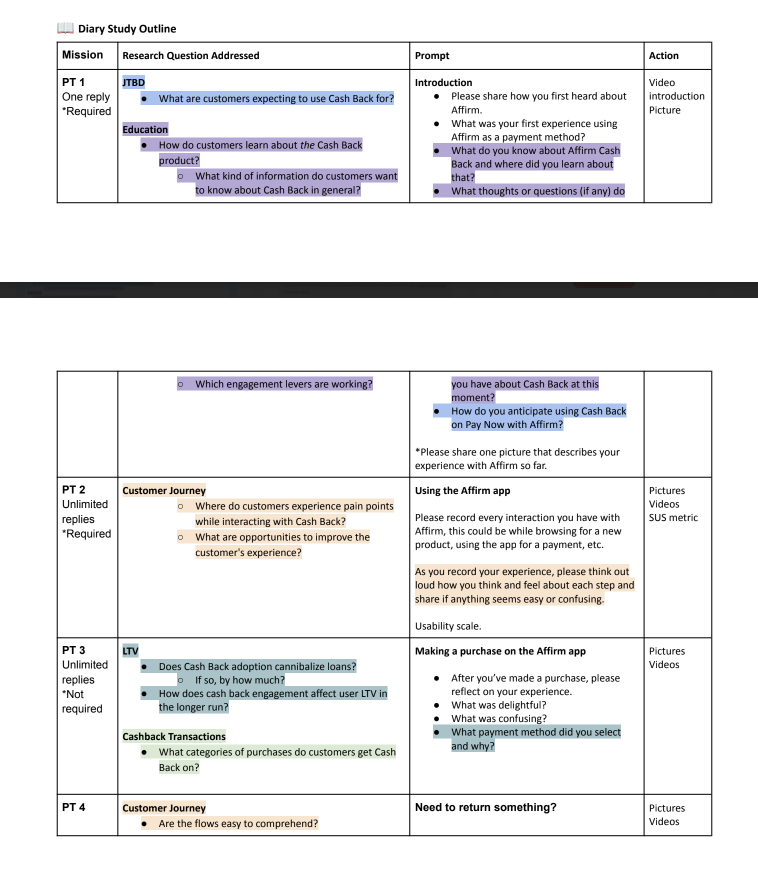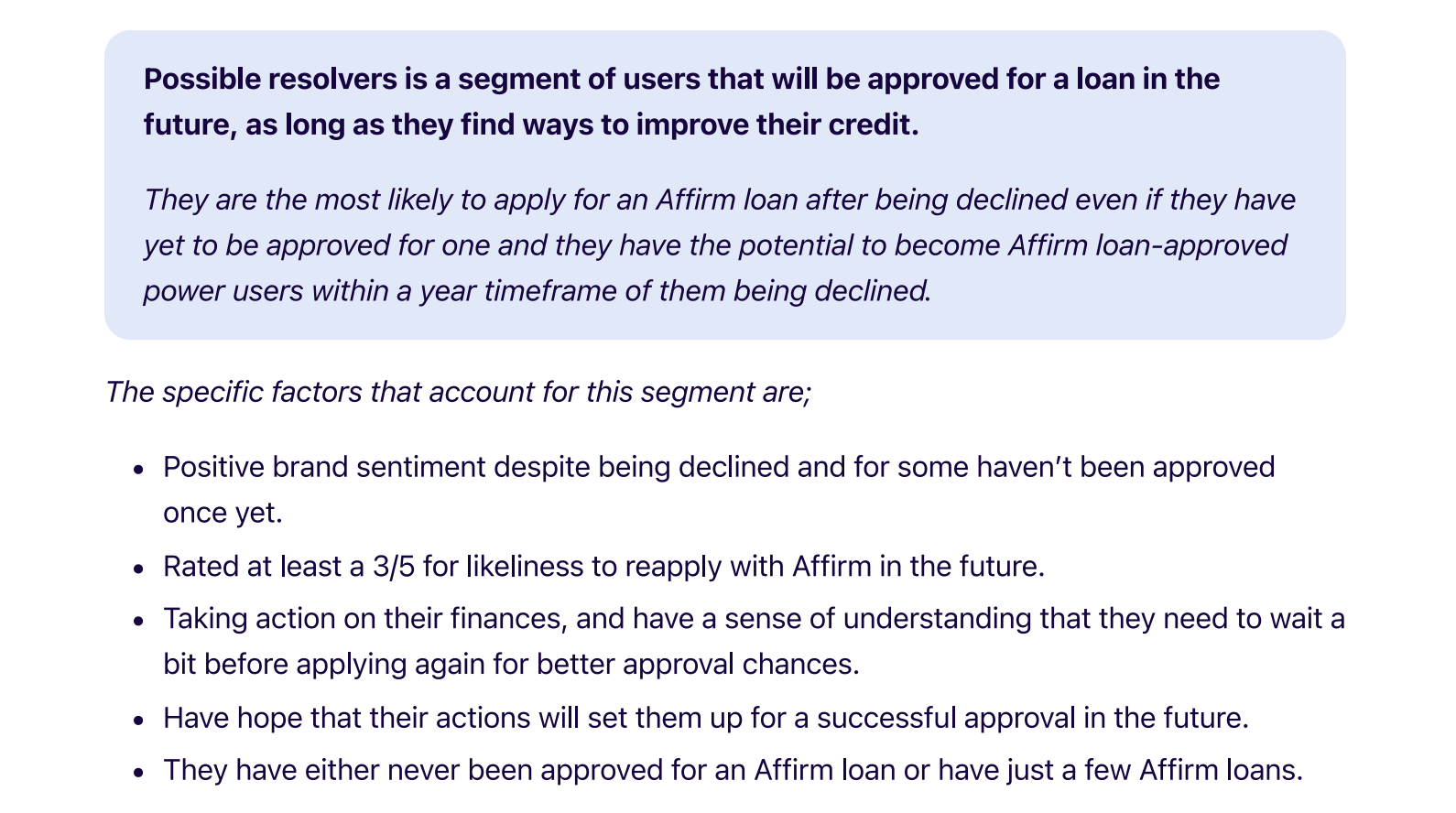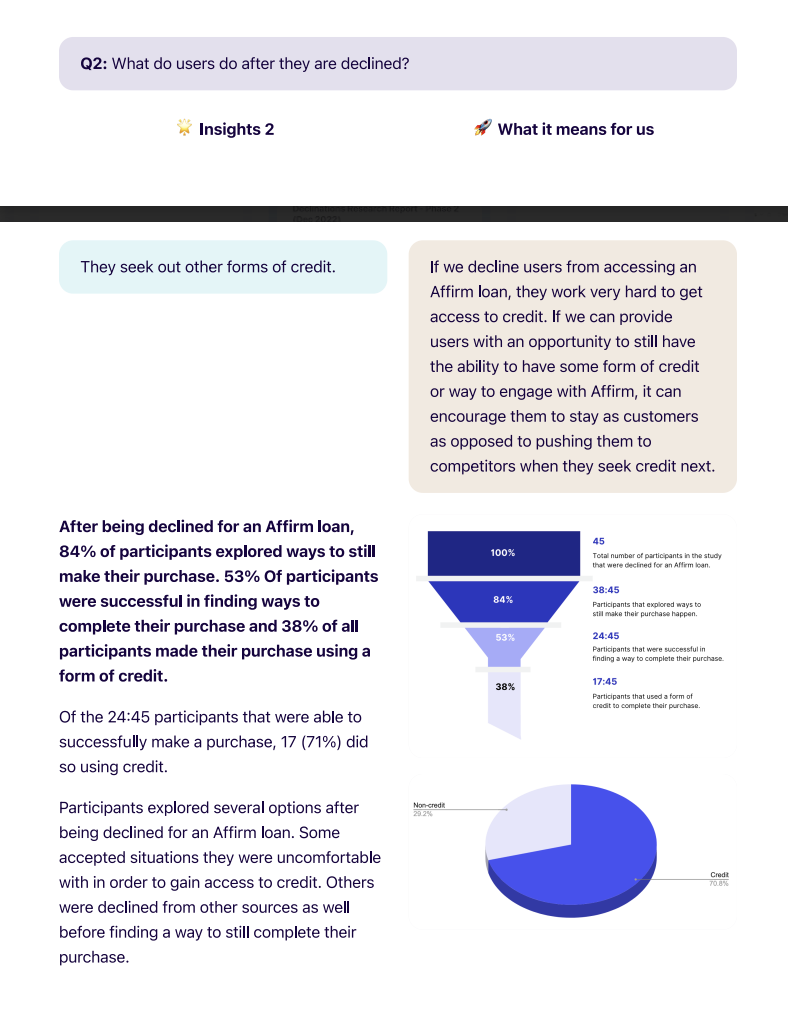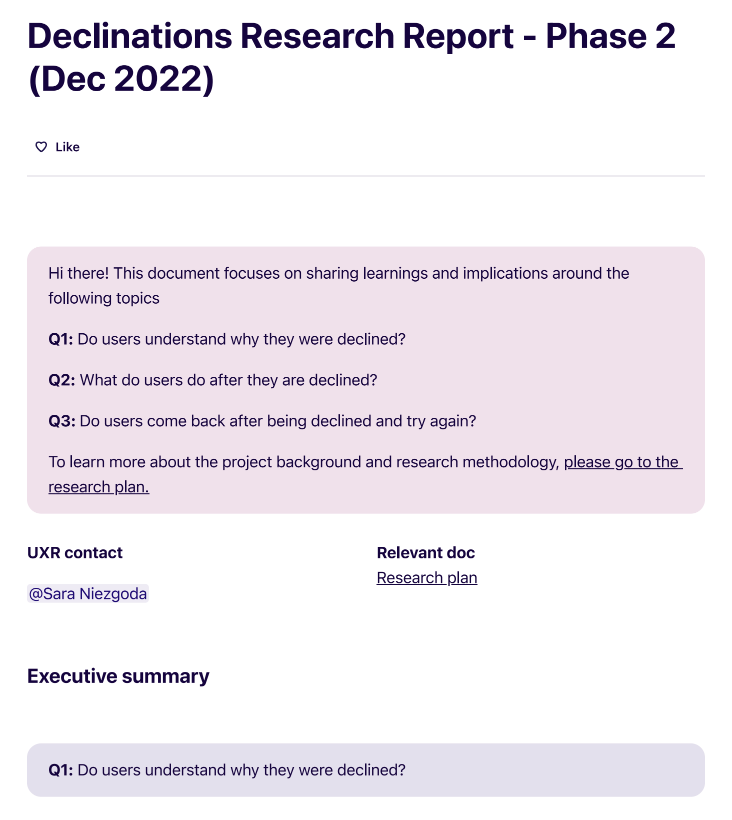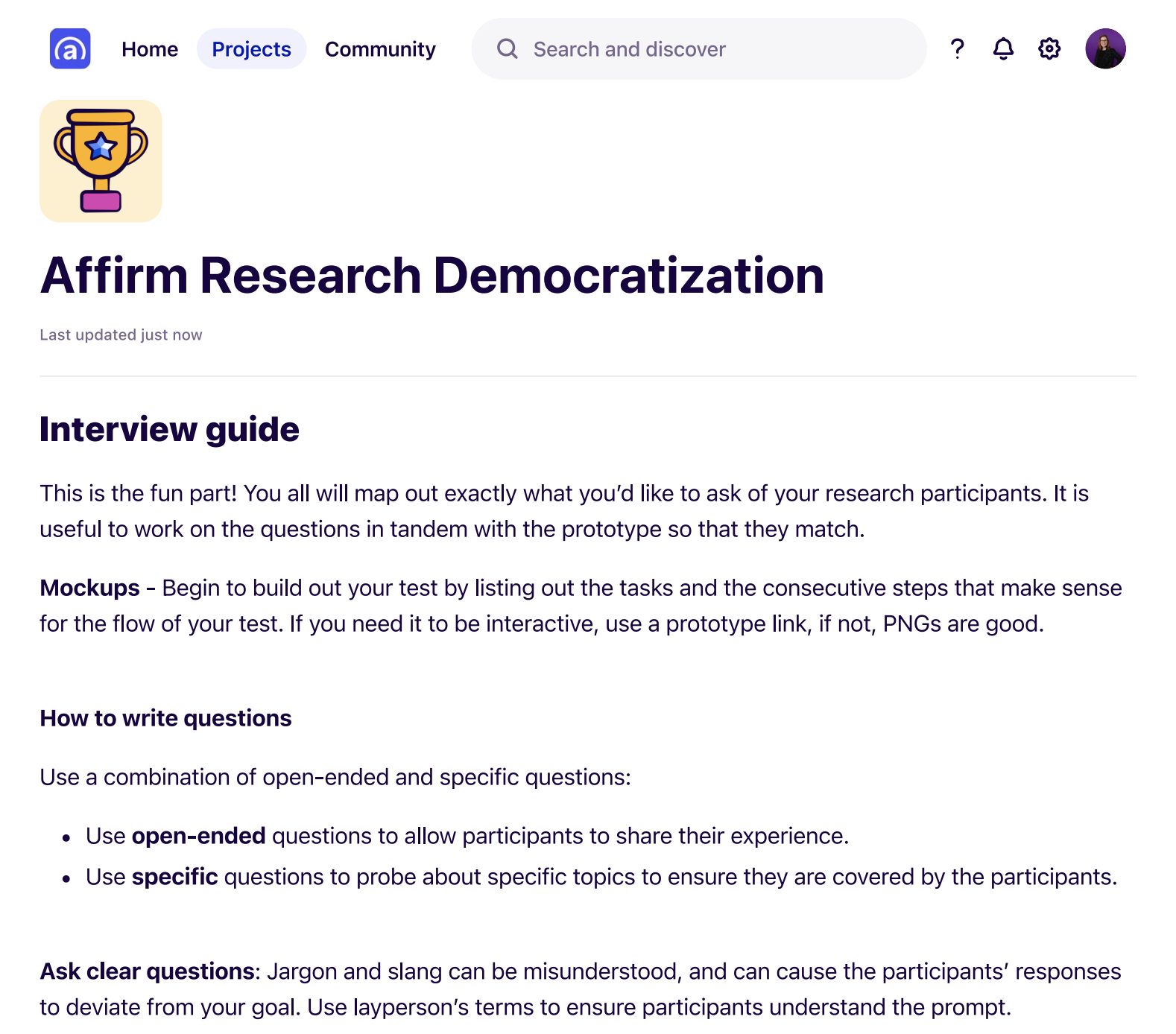Affirm
Affirm is a publicly traded financial technology company, that operates as a lender of installment loans for consumers to use at the point of sale to finance purchases.
Role: User Researcher
Duration: June 2021 - February 2023
Overview
I joined Affirm as part of an 11-person User Researcher team to support a 2,000+ person company.
In my initial role, I served as the lead researcher for the Rewards team, where I conducted a comprehensive Diary Study to evaluate the comprehension of their Cash Back Rewards program.
After the Rewards project concluded, I redesigned the company’s Research Democratization program and built it to scale.
While in the process of launching the Research Democratization program's enhanced 2.0 version to meet growing demand, I was presented with an additional opportunity. I was entrusted with the role of Head of Research for the Servicing and Repayment team, the largest and most recent addition to the company's internal organization. As the sole researcher for this team, I was responsible for establishing a robust research framework from scratch and supporting their urgent research needs.
Research Process Overview
Any given research project may include the following steps:
Needs Assessment
Identify themes and prioritization
Build research plan
Conduct research prep-work
Conduct research
Process data
Organize data
Synthesize data
Identify insights, themes, opportunities, and golden nuggets
Research Report
Circulate Insights
Research Process Breakdown
The UX research process that I follow is not linear and it depends on many factors such as the team’s needs, project requirements/prioritization, and resourcing.
Needs assessment
A needs assessment can encompass various approaches within the realm of research.
When serving as a dedicated research partner for a team, I find it valuable to conduct monthly or quarterly scoping workshop meetings with key stakeholders.
The purpose of these meetings is to identify the team's current challenges and questions, as well as anticipate upcoming inquiries. I also strive to provide the team with pertinent information by addressing questions from previous workshops and offering data-driven answers. This helps the team gauge the extent of their knowledge and identify areas that require further exploration.
Additionally, alongside these comprehensive scoping workshops, there are occasional smaller project requests that arise while I am engaged in other ongoing projects. To handle these ad hoc requests, I carefully assess their business significance and determine whether they take priority over my existing projects. If the request aligns with my available bandwidth, I either incorporate it as a full project or adapt it as a modified democratized research endeavor. In cases where my availability is limited, these projects can be slated for the subsequent team scoping workshop if they remain relevant.
By conducting regular scoping workshops and addressing project requests strategically, I aim to ensure that the research efforts align with the team's needs and priorities, fostering a comprehensive and well-informed approach.
Identify themes and prioritization
To organize the questions and prioritize them, themes are identified based on company goals and available resources. This forms the foundation for building the research plan.
Build research plan
The research plan involves selecting the most suitable research methods based on the required data, considering resource constraints and timelines.
It includes elements such as hypotheses, screeners, scripts, prototypes, timelines for each step of the project, and plans for socializing the research findings.
Conduct research prep-work
The preparation work required for research projects can vary depending on the type of research being conducted. Even for seemingly straightforward usability projects, it is essential to engage with key team members to secure the necessary support and ensure a thorough and timely execution aligned with project deliverables.
Certain research methods may involve the involvement of legal and compliance teams, particularly when consent forms or participant rewards are required. Collaboration with these teams ensures that all necessary legal and ethical considerations are addressed appropriately.
Participant recruitment processes may vary based on the research methodology and participant criteria. Different strategies may be employed to identify and recruit suitable participants for the study.
Before launching the actual research project, it is crucial to conduct thorough pilot tests. This step validates that the research approach effectively addresses the key objectives of the project and ensures that information is conveyed clearly to encourage participant engagement.
Conduct research
Once the research plan is in place, the exciting phase of conducting the research begins. This involves actually carrying out the research activities, which may include interviews, observations, or other data collection methods.
Process data
After collecting the data, it needs to be processed. This involves watching videos of participants (if conducting unmoderated interviews), downloading videos, transcribing them, and organizing any qualitative or quantitative responses from participants in a data repository.
Organize data
Once all the research data, including transcripts, are consolidated in a centralized location, I begin exploring and tagging the data using Project Tags that I create, tailored to each specific project.
These tags enable a granular analysis, delving into each action and capturing key themes, general insights, and valuable opportunities.
After meticulously tagging the data, I proceed to arrange the tags in an affinity map format. This visualization technique helps identify connections, patterns, and relationships between different tags, enabling a holistic understanding of the research findings.
In addition to the qualitative data tagging process, I also organize any quantitative data from the project.
This may involve maintaining a separate Excel spreadsheet dedicated to quantitative insights, allowing for efficient organization and analysis of numerical data.
By diligently exploring, tagging, and organizing both qualitative and quantitative data, I ensure a comprehensive and structured approach to derive insights and identify actionable opportunities from the research findings.
Synthesize data
During the data synthesis phase, I review each tagged cluster and extract a few key themes or takeaways that emerge from the data. These themes serve as essential contextual information when crafting the research report.
As I identify these themes and observations, I pay particular attention to the most relevant and supportive pieces of data within each cluster. This could include video clips, quotes, or other data points that strongly reinforce or exemplify the identified themes. To ensure easy retrieval for the research report, I apply special markings or annotations to these noteworthy data elements.
By carefully curating and highlighting these significant data snippets, I can effectively leverage them in the research report to illustrate and substantiate the key themes and insights derived from the data analysis.
Identify insights, themes, opportunities, and golden nuggets
After synthesizing all the data, I adopt a holistic perspective and analyze the bigger picture that emerges. At this stage, it is crucial to cut through the abundance of information and discern underlying themes that may not be immediately apparent. This ability to identify subtle yet significant patterns and insights is where the magic happens for a researcher.
By processing and distilling the synthesized data, I strive to uncover those golden nuggets of opportunity and insight that hold immense value. These hidden gems provide unique perspectives and actionable recommendations for the team.
Build research report
Leveraging these valuable findings, my next step is to skillfully craft a captivating and insights-driven story.
Through this storytelling approach, I can effectively communicate the research findings in a cohesive and impactful manner, ensuring that the team is fully informed and genuinely inspired by the generated insights and recommendations.
To enhance the effectiveness of the storytelling process, I break down the insights and recommendations based on their timeliness, impact, and resource requirements.
This strategic breakdown allows the team to prioritize and understand the urgency, significance, and necessary resources associated with each insight or recommendation.
By presenting the findings in this structured and actionable manner, I empower the team to make informed decisions and take the appropriate steps to address the identified opportunities or challenges.
This approach ensures that the research report not only informs but also motivates the team to take meaningful action based on the valuable insights uncovered.
Circulate Insights
Insights are then circulated to the appropriate stakeholders through share-outs or presentations.
If new questions arise or existing ones remain unanswered, additional research may be required to address them effectively.
Case Studies
Research Democratization Training Program
Founded a Research Democratization Training Program (RDTP), adopted by 500+ company-wide team members (from Engineering, Product Managers, Project Managers, UX Designers, and Content Writers) resulted in +400% project growth, spanned 300+ interviews in one year, and saved 4,800+ research hours.
Declinations Research
Research rollup that explored how might we understand which declination to focus on to best reengage users after declination.
Cash Back Diary Study
A 6-week Diary Study to explore the comprehension and expectations of the Cash Back feature for the Rewards team.
